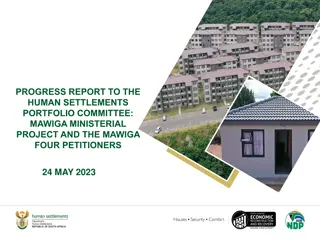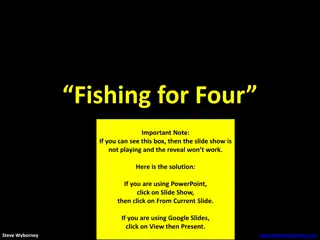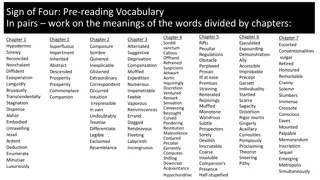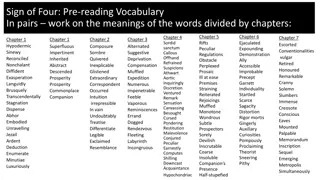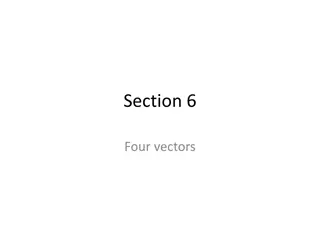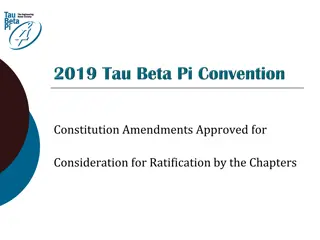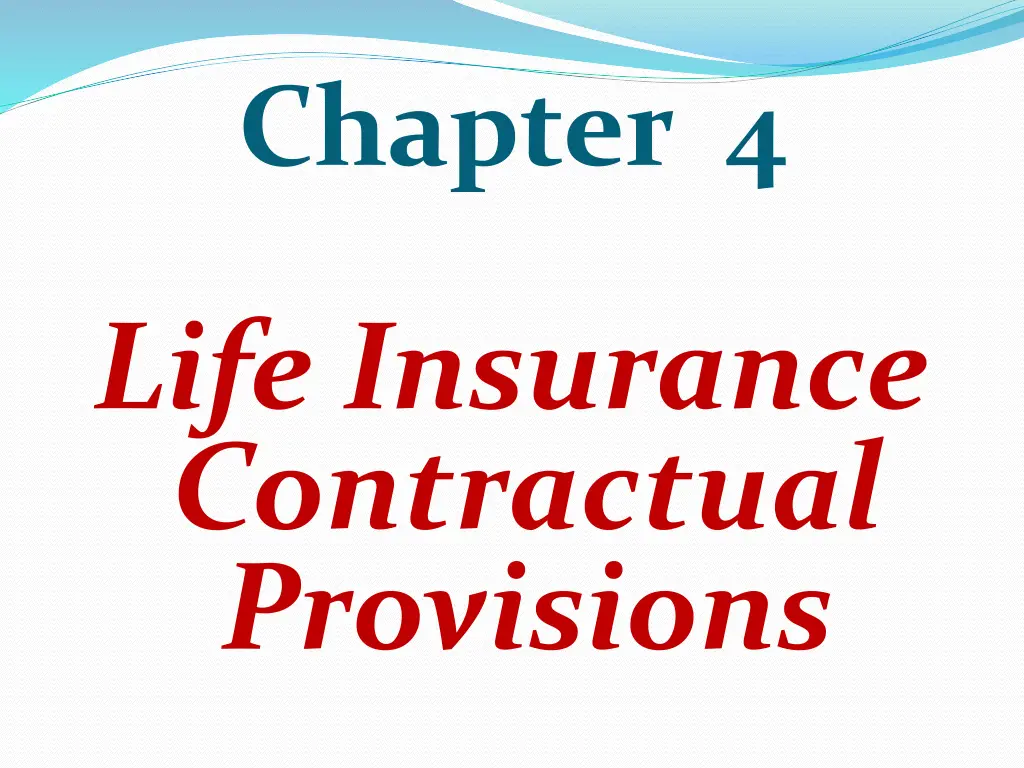
Understanding Life Insurance Contractual Provisions
Explore the key contractual provisions of life insurance, including ownership clause, entire contract clause, incontestable clause, suicide clause, grace period, and reinstatement clause. Learn about the rights and responsibilities involved in a life insurance policy.
Download Presentation

Please find below an Image/Link to download the presentation.
The content on the website is provided AS IS for your information and personal use only. It may not be sold, licensed, or shared on other websites without obtaining consent from the author. If you encounter any issues during the download, it is possible that the publisher has removed the file from their server.
You are allowed to download the files provided on this website for personal or commercial use, subject to the condition that they are used lawfully. All files are the property of their respective owners.
The content on the website is provided AS IS for your information and personal use only. It may not be sold, licensed, or shared on other websites without obtaining consent from the author.
E N D
Presentation Transcript
Chapter 4 Life Insurance Contractual Provisions
LIFE INS. CONTRACTUAL PROVISIONS 1-OWNERSHIP CLAUSE: the owner of a life insurance policy can be the insured, beneficiary, a trust, orany party. the -In most cases, the applicant, insured & owner are the same person. -Policyowner possess all contractual rights in the policy while the insured is living, that include: naming & changing the beneficiary, surrendering the policy, borrowing CV, receiving dividends, changing the owner and electing settlement beneficiary s consent). options (w/out the
LIFE INS. CONTRACTUAL PROVISIONS 2-ENTIRE-CONTRACT that the life application constitute the entire contract between the parties. CLAUSE: policy states insurance & attached Purposes of the entire contract clause: - Prevents the insurer from amending the policy w/out the knowledge or consent of the owner by changing its charteror by laws. - Protects the beneficiary.
LIFE INS. CONTRACTUAL PROVISIONS 3- INCONTESTABLE CLAUSE: stated that the insurer cannot contest (dispute) the policy after it has been in force for 2 years during the insured s lifetime. Ex: fraud: Insured said I don t have blood pressure but he has. Except: fraud of gross nature like letting someone take your medical examination, insurer won t pay, no insurable interest at inception, beneficiary take out insurance with intention of murdering the insured.
LIFE INS. CONTRACTUAL PROVISIONS 4- SUICIDE CLAUSE: states that if the insured commits suicide within years after the policy is issued, the face amount of insurance will not be paid; but only are fund of the premiums paid. Purpose: to reduce adverse selection against the insurer (individual buys insurance with intention of committing suicide).
LIFE INS. CONTRACTUAL PROVISIONS 5- GRACE PERIOD: the policyowner has a period of 31 days to pay an overdue premium & if he dies within it, the overdue premium is deducted from the policy proceeds. Purpose: to prevent the policy from lapsing if insured in a short of funds or have forgotten to pay the premium.
LIFE INS. CONTRACTUAL PROVISIONS 6- REINSTATEMENT CLAUSE:permits the owner to reinstate a lapsed policy. Requirements to reinstate a lapsed policy: 1- Evidence of insurability. 2- Overdue premiums + interest must be paid. 3- Policy loan must repaid or reinstated + interest. 4- Policy must not have been surrendered. 5- Policy must be reinstated within 3 or 5 yrs from the date of lapse.
LIFE INS. CONTRACTUAL PROVISIONS Advantage to reinstate a lapsed policy rather than purchase a new one: 1- Premium is lower because there instated policy was issued at an earlier age. 2- Acquisition expenses incurred in issuing the policy must be paid again under a new policy. 3- CV & dividends are usually higher under the reinstated policy (CV in new policy after 3 yrs).
LIFE INS. CONTRACTUAL PROVISIONS 4- Incontestable period & suicide period under the old policy may have expired. 5- Reinstated policy may contain favorable provisions, such as a 6% intereston policy loans. Disadvantage to reinstate a lapsed policy rather than purchase a new one: 1- Substantial cash amount is required if the policy lapsed several yrs ago. 2- Most life insurers have reduced their rates over time & have developed new products, so, may be it is better to buy a new one.
LIFE INS. CONTRACTUAL PROVISIONS 7- MISSTATEMENT OF AGE OR SEX CLAUSE: If the insured s age or sex is misstated, the amount payable is the amount that the premiums paid would have purchased at the correctage & sex. 8- BENEFICIARY DESIGNATION: beneficiary is the party named in the policy to receive the policy proceeds.
LIFE INS. CONTRACTUAL PROVISIONS The principal types of beneficiary: 8/1 Primary & contingent beneficiary: - A primary beneficiary is first person entitled to receive the benefits on the insured sdeath. - A contingent beneficiary is entitled to the proceeds if the primary beneficiary dies before the insured. 8/2 Revocable & irrevocable beneficiary: - A revocable beneficiary means that the policyowner reserves the right tochange him w/out his consent. - Irrevocable beneficiary cannot be changed w/out the beneficiary s consent.
LIFE INS. CONTRACTUAL PROVISIONS 8/3 Specific & class beneficiary: - A specific beneficiary means the beneficiary is specifically named & identified. - A class beneficiary is a member of a group designated as beneficiary, such as children of the insured . 9- CHANGE OF - PLAN PROVISION: allows policyowners toexchange their policies toanotherone. 10- EXCLUSIONS & RESTRICTIONS: Excludes payment if the insured dies as a direct result of specific peril (war, suicide, ).
LIFE INS. CONTRACTUAL PROVISIONS 11-PAYMENT OF PREMIUMS: can be paid annually or semiannually, quarterly, or monthly (+interest). 12-ASSIGNMENT CLAUSE: 2 types: 1/12- Absolute assignment: all ownership rights in the policy are transferred toa new owner. 2/12- Collateral assignment: the policyowner assigns a life insurance policy as collateral for a loan (rights are transferred to the creditor to protect its interest up to the loan value & the policyowner retains the remaining rights).
LIFE INS. CONTRACTUAL PROVISIONS 13- POLICY LOAN PROVISION: allows policyownerto borrow the cash value (w interest). Advantage: low rate of interest. Disadvantage: policy could lapse if the total debt exceeds the CV. 14- AUTOMATIC PREMIUM LOAN: anover due premium is automatically borrowed from CV after the grace period expires, if CV is sufficient to pay the premium. Disadvantage: may be overused & policy terminated & amount will be reduced if the premium loans are not repaid.
LIFE INS. CONTRACTUAL PROVISIONS 15- NONFORFEITURE OPTIONS: payment to a with drawing policy owner is known as a non forfeiture value or C surrenderV. There are 3 nonforfeiture options or C surrender V options: 15/1- Cash value. 15/2- Reduced paid-up insurance (small amount but same policy). 15/3- Extended term insurance (same amount but term policy).
LIFE INS. CONTRACTUAL PROVISIONS 16- DIVIDENDS OPTIONS: derived from 3 sources: expected mortality > actual; interest > expected on reserves & operating expenses < expected. dividends are Several ways in which dividends can be taken: 16/1- Cash. 16/2- Reduction of next premium 16/3- Accumulate at interest. 16/4- Paid-up additional insurance amount at pure rate & w/out insurability. 16/5- Term insurance.
LIFE INS. CONTRACTUAL PROVISIONS 17- SETTLEMENT OPTIONS: ways that the policy proceeds can be paid to beneficiary other than the lamp sum. 17/1- Interest option: interest paid periodically & insurance amountatanytime. 17/2- Fixed-period option: principal & interest paid periodicallyduring a specific time. 17/3- Fixed-amount option: specific amount from principal & interest paid periodically until it is done. 17/4- Life income options: paid as annuity in 6 ways:
LIFE INS. CONTRACTUAL PROVISIONS 1- Life income (pure): insurance amount used as single premium for annuity paid as long as beneficiary still a life. 2- Life income w certain period: paid as long as beneficiary still a life or for specific period which ever occurs last. 3- Life income w Cash Refund: if beneficiary dies before: annuities received = insurance amount, a 2nd beneficiary receives a lamp sum = insurance amount annuities received.
LIFE INS. CONTRACTUAL PROVISIONS 4- Life income w installment Refund: if beneficiary dies before: annuities received = insurance amount, a 2ndbeneficiary receives an installment = insurance amount annuities received. 5- Joint & Survivor Annuity: paid to 2 beneficiaries (husband & wife) up to second death (may reduced after firstdeath). 6- Use as trust: paid to a trustee if kids are young or needs change overtime.
LIFE INS. CONTRACTUAL PROVISIONS 18-WAIVER OF PREMIUM: due premium will be waived if the insured becomes totally & permanently disabled before a specific age (65) either for whole life or annuityor health. 19-GUARANTEED INSURABILITY (PURCHASE) OPTION: insured can buy extra amount w/out insurability in the future ( he can tafford high premium now).
LIFE INS. CONTRACTUAL PROVISIONS 20-AMOUNT OF INSURANCE: allows the policyowner to buy extra amount every 3 yrs up to some max age (45) w/out insurability. 21-ADVANCE PURCHASE PRIVILEGE: Insured can buy extra amount w/out insurability 1 or more time up to specific age or at some events (marriage, birth or adoption of child). 22-ACCIDENTAL DEATH BENEFIT: provides double or triple or more of face amount in case of death within 90 days as a result of accident before specificage.
LIFE INS. CONTRACTUAL PROVISIONS 23-COST OF LIVING: if needs changew time it provides faceamount that is tied tocostof living. 24-ACCELERATED DEATH BENEFITS: A rider that pays all or part of the face amount prior to the insured death because of some adverse medical condition & takes 3 forms: 24/1- Terminal Illness Coverage: pays 25-50% of the face amount w min & max amount in case of terminal illness with physician certificate, hospital or nursing records & medical examination paid by the insurer.
LIFE INS. CONTRACTUAL PROVISIONS Remaining death benefits, prem., CV, & dividends reduced proportionately. 24/2- Catastrophic Illness Coverage: as terminal illness if insured have one of listed catastrophic illness (stroke, cancer, ). 24/3- Long Term Care Coverage: monthly benefits paid if insured confined at hospital or during convalesce (recover) at homecondition (w conditions).




